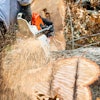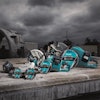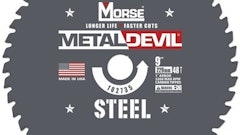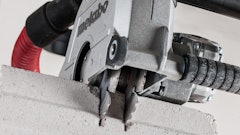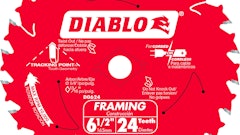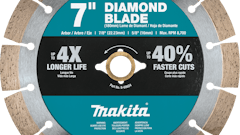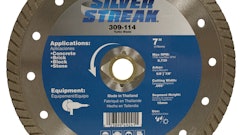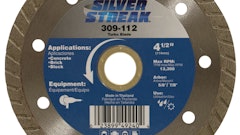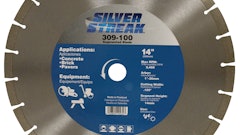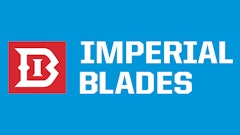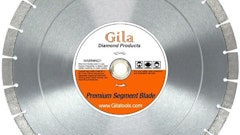Making a profit from your diamond blade inventory involves more than buying a couple of boxes of blades and sticking them on a shelf with the hope that your customers will find what they need. To start with, there are so many different blades to choose from: economy and premium, wet- and dry-cutting, those designed for cutting asphalt, those made for cutting green concrete and everything in between. Thankfully, there are a few things you can do to ensure your customers leave your store with the right blades, are satisfied with their performance and finally, that you've made some money from those blades at the end of the day.
The first thing to do is determine what your primary customer base demands in terms of diamond blades and then promote those blades. "Buy only what you need," advises Tom Head, eastern regional sales manager for Target. "Display what those blades are used for and what equipment they're used on. You don't want to have too many products and confuse the customer."
In short, Head says rental businesses should make their displays as simple as possible. The main thing is ensuring your customers are aware of what you have to offer.
"The display needs to be credible," adds Nick Papadopoulos, eastern regional sales manager with Norton Construction Products. "You need to have blades that cater to your customers' needs and you can't rely on people walking in and seeing them. Your outside and inside sales people need to make customers aware too."
Norton is in the process of launching a new display system that utilizes pictograms to help customers choose the right blade for their needs. "We've taken all the rocket science out of it," he says. "The pictograms don't require a lot of effort to understand." In addition, all written explanations are in English, Spanish and French.
Where your blade display is located can have an impact on its effectiveness as well.
"Have your display rack next to the counter to encourage impulse buys," Head says, noting that Electrolux offers a point of purchase display rack that can be personalized to individual rental businesses.
Most blade manufacturers today do offer some sort of point of purchase display system and also label blades according to their application, a trend that's continuing to improve over time.
"In the past, we've made up our own labels to help customers," recalls John Gauer, owner of Gauer Rental in Akron, OH, which rents and sells blades and tools from Diamond Products. "Every manufacturer needs to improve their labeling, but it's gotten a lot better and has really caught up now."
Educate your employees
A simple and informative display system can go a long way toward helping customers choose the right blade for their job, but nothing compares to knowledgeable counter help. When combined, a good display system and a knowledgable employee can be an excellent marketing tool.
"You need to provide your employees with continuing education on what blades are needed for what applications," says Gauer. "You need to train your counter people to talk to the customers and you have to watch them to make sure they do give customers what they need."
Gauer points out that the risk of renting or selling customers the wrong blade for the job is too high to neglect employee training.
"You can't let customers leave with the wrong blade, otherwise the customer isn't happy and no one makes any money. To make a profit, your counter people need to know what they're doing."
Papadopoulos agrees, adding, "Rental businesses have to be able to communicate with their customers and know what questions to ask."
In addition to knowing the blade inventory inside and out, employees also have to be able to judge the condition of the equipment housing the blade in order to facilitate the best results for the customer. Papadopoulos explains, for example, that if high-speed saws don't run at the correct rpm because they've been abused or improperly maintained, it will cause undue wear on the blade and performance will suffer.
"What you're putting that blade on is a key component to the blade's profitability," says Papadopoulos. "That's more important than any rental program."
To lessen this problem, Norton, for example, will conduct courtesy saw inspections and will help educate rental personnel on how to inspect saws for problems that can impair saw and blade performance.
"Make sure your equipment is rental ready," says Papadopoulos. "And that the guy working on the equipment is aware of what problems he should be looking for."
A question of quality
How a blade performs and what you can expect in terms of profitability are tied to its quality, and there is a wide range of quality on the market today.
"There's been a shift toward cheaper blades in recent years, causing rental businesses to sell more blades than rent them," Papadopoulos says. "There's a lot of offshore stuff coming in that's of lower quality."
On the bright side, even high-quality blades are cheaper for rental businesses to acquire today than in the past. For example, a 14-inch diamond blade that might have cost $350 to $400 two decades ago could very well cost only $150 today. If used properly, the blade can turn a profit more quickly. On the other hand, if the blade is of lesser quality, it might have a shorter life, making profitability more difficult.
According to some manufacturers, the lowering of blade prices is due to technological changes.
Head at Target says it used to cost blade manufacturers more to buy diamonds from General Electric, the main U.S. supplier of synthetic diamonds for blade manufacturing. Now Asian suppliers are able to manufacturer diamonds as well, making them less expensive. What's more, there are more blade manufacturers operating today, which also drives prices down.
"Twenty years ago, we had one or two competitors and now there are dozens because the ability to make diamond blades is more available," Head says.
He continues, "The [foreign] blades have gotten much better. They used to have a lot of inconsistencies, but they're more accurate today. Still, you get what you pay for."
Because of the influx of inexpensive, foreign blades, domestic blade manufacturers have had to take a new approach to marketing their wares. Some, like Norton, have introduced an economy diamond blade that serves the needs of smaller contractors who want to save money. For bigger and specialty contractors, they offer Premium and Supreme blades that have a higher diamond concentration and promise a longer life.
For its part, Target recently introduced its Hi-5 blade intended for general purpose applications. According to Head, it features a unique slotted segment design that allows it to cut a full range of materials.
Whether you choose to stock economy or premium blades - or a mix of both - depends on the needs of your customer base.
"We rent a medium-grade blade," says Gauer at Gauer Rental. "We sell a lot of low-end blades because that's where the growth is. There's a much higher availability of imported, low-end blades than there was 10 years ago. Now it's getting to the point where we'll be buying diamond blades by the box like abrasive blades."
Just because blades are cheaper for rental businesses to acquire doesn't necessarily mean they'll turn a profit more quickly.
"We had to lower the rental price of a 14-inch, wet, walk-behind blade because our competitor lowered his rental price of cheaper blades," Gauer points out.
After-sale support
To make money from your blade inventory, customer satisfaction is key, and so is your relationship with your supplier.
"Make sure you make the proper recommendations," instructs Head. "If not, the customer will be unhappy. Be sure to follow up to make sure the blade is performing to the customer's expectations."
He continues, "There are so many blades out there. Everyone makes a pretty decent product. A lot of what makes the difference is relationships... will the manufacturer support its products after the sale, is there a good warranty, etc."


